The Golden Gate is very much in the news today, as it has become a point of conflict between Jews and Muslims, or Palestinians and Israelis.
But what do we know about this gate?
The Golden Gate, around which swirl various traditions, is the most intriguing of all the gates of the Temple Mount. In Jewish tradition, it is through this gate (Sha’ar haRachamim—Gate of Mercy), blocked since the ninth century, that Messiah will enter at the end of days, led in by the prophet Elijah. This is based on the prophecy of Ezekiel 44.1–3. Christians believe that Christ made his triumphal entry into Jerusalem (recorded in all four of the gospels) through this gate on the Sunday before his crucifixion (Palm Sunday). By riding on a donkey, he fulfilled the messianic prophecy recorded in Zechariah 9.9. Muslims refer to it as the Gate of Eternity (Bab-al-Dahariyeh) and believe it will be an important part of the last judgment of mankind. The Muslim cemetery along the Eastern Wall is thought to have been placed there in the belief that the forerunner of Messiah, Elijah, being of a priestly family, could not pass through the Golden Gate, thus preventing the coming of the Messiah.
Some claim that the Golden Gate was built by the Byzantine emperor Heraclius after the expulsion of the Sassanians from Jerusalem. However, the absence in the architectural decorations of any Christian symbols, such as a cross makes that difficult to believe. There are actually four distinct historical phases represented in the architecture of this gate: Turkish, Umayyad, Herodian and First Temple period. In the 1970’s I was privileged to spend one week inside this gate, measuring and recording its plan and drawing accurate elevations of all the interior surfaces.
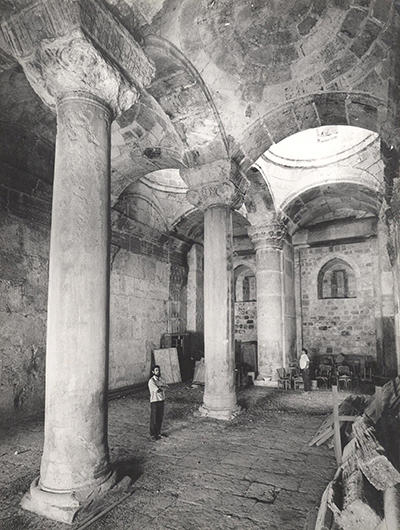
The Golden Gate’s outer façade is composed of two blocked-up gateways adorned with intricately carved relief arches. The decoration of the arches to the front and back of the gate are identical to the applied arches of the Double Gate which date from the Early Islamic period. The gate appears therefore to have been rebuilt in the Umayyad period, on the foundations of an earlier gate.
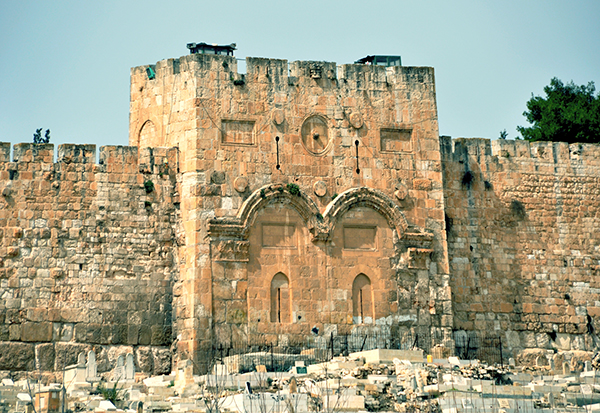
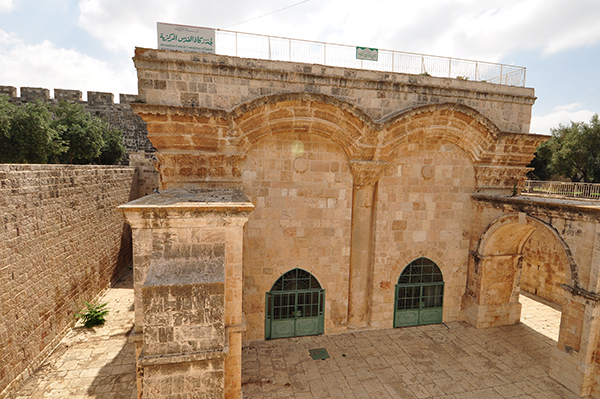
The remains of two massive monolithic gateposts are preserved inside this gate.
The gateposts are set in the same line as the Eastern Wall of the Temple Mount and line up with the massive masonry that can be seen on either side of the Golden Gate.
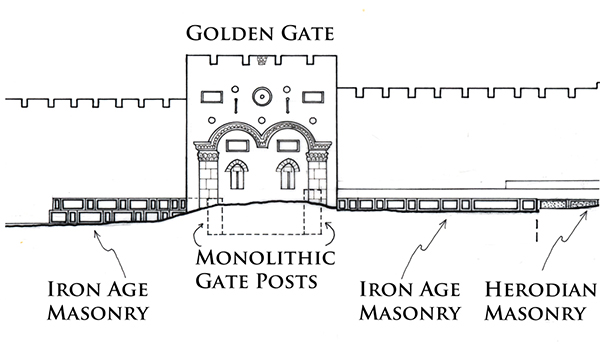
The gateposts and the two masonry sections appear therefore to be part of the same construction. The top of the southern gatepost is level with the top of the ancient masonry that can be seen south of the Golden Gate. The northern gatepost is one stone course higher and is located only one stone course below the surface of the Temple Mount. This means that the top of the original lintel would have been identical with the present-day level of the Temple Mount. The two gateposts belong to a gate that dates from the First Temple period and is most likely the Shushan Gate, mentioned in Mishnah Middot 1.3 as the only gate in the Eastern Wall.
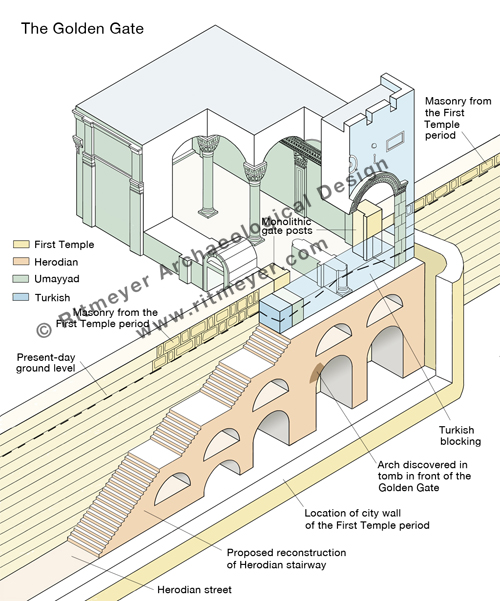
The gate most probably was given this name by builders who had returned from exile in Babylon and for whom the Palace of Shushan lived on in their memories. However, if so there would have been a tradition of an eastern gate in this location from the time of the construction of the original Eastern Wall. It seems reasonable to suggest that the central section of the Eastern Wall dates from the First Temple period, in particular to the time of King Hezekiah. This square mount was extended south in the Hasmonean period, while both the southern and northern additions were made by King Herod the Great.
In 1969, the remains of an underground arch were discovered inside a grave in front of the Golden Gate. It was suggested that this may have been a pre-Herodian gateway. However, as the arch stones appear to be Herodian, it is more reasonable to suggest that this arch was part of a Herodian staircase leading up to the original gate. It is fascinating to contemplate that the stairway may still be intact under this gate, although hidden from sight by the Muslim Cemetery.
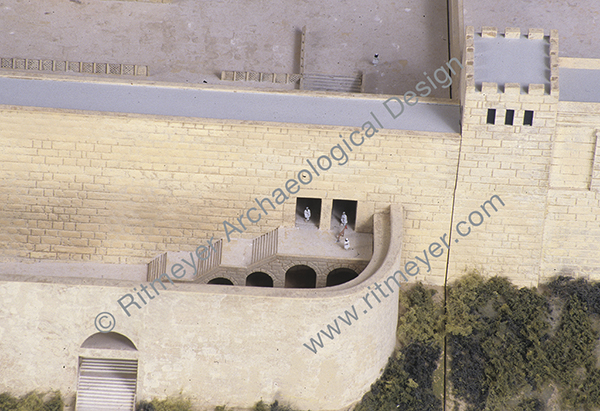
We do know that the remains of an ancient city wall lie under the present-day path that runs through the Muslim cemetery, which was discovered by Warren in the 1860s. The above-mentioned arched stairway led down through a gate in this city wall, the so-called Miphkad (Muster, or Inspection) Gate mentioned in Nehemiah 3.31, apparently still in use in the Second Temple period. During the latter period, it was through these gates that the Red Heifer was led out from the Temple Mount to the Mount of Olives (Mishnah, Parah). On the Day of Atonement, the scapegoat was led by the same route into the wilderness (Mishnah, Yoma).
It is therefore obvious that the Golden Gate is a very important historical building for the Jewish people, as reported by Arnon Segal of the Hebrew newspaper Makor Rishon Here is a translation of the article that refers to my research:
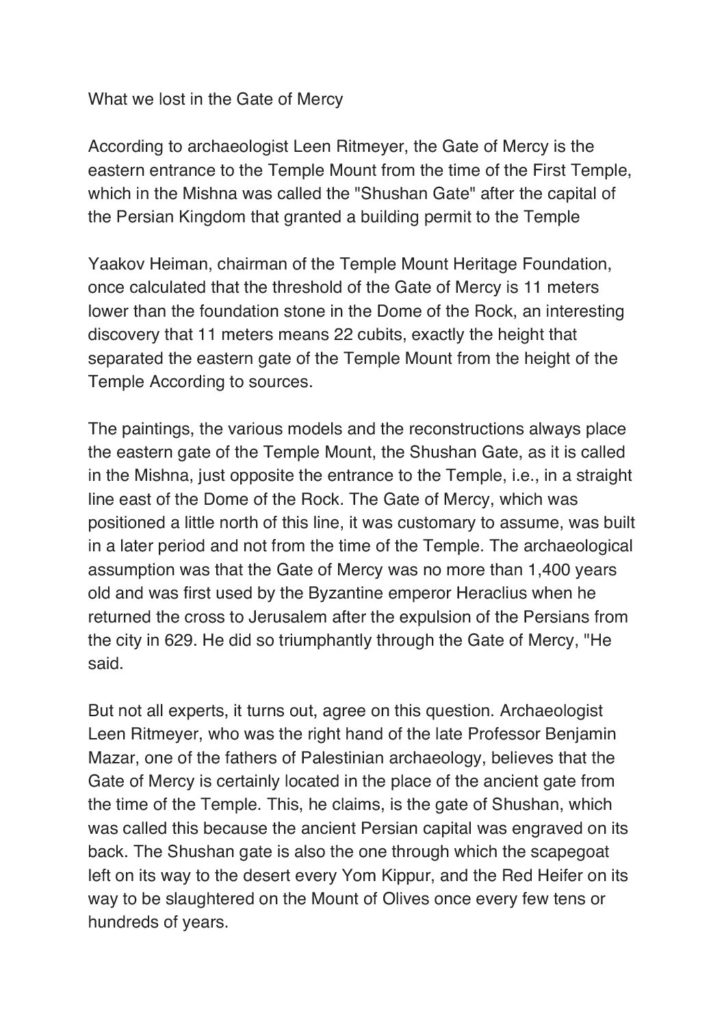
HT: Dr. Eli David

Jessica, thank you for your kind comment and glad it helps you in Brazil.
Dear brother Leen. On the page above there is a photo caption that on my browser at least, has no photo. The caption reads “Section through the Golden Gate looking north, showing the massive monolithic gatepost.” Am I missing something? I would love to see the photo.
Don’t know why your browser didn’t show it. Will email it to you.
As a follow-up to Peter Collins, and to notify Leen, my browser (OPERA) is displaying the pic fine. It is also visible here. https://www.ritmeyer.com/wp-content/uploads/2019/03/Golden-Gateblog.jpg
I think you’re right, Daniel. It must be a browser problem as I haven;t heard this complaint from anybody else.
Something is amiss. The wall above the Shushan Gate had to be lowered so that the high priest could see over it directly into the sanctuary. My research shows a straight line of sight from the red heifer altar over the Shushan and directly into the sanctuary. Hollis tried to use an oblique line of sight but he had to (1) make the massive towers around the Nicanor Gate much smaller to accommodate his line of sight work and (2) lower the eastern wall next to the Temple instead of lowering the wall on the eastern wall of the traditional mount. Thus he alters Maimonides and the Mishnah. We just visited the eastern wall and saw no remains of a gate in the Arab cemetery directly across from the Dome of the Rock. We were in the Dome (also in and under the Al-Aksa) and the rock there rises 5 feet off the floor. The Mishnah says it must be a three-fingered high stone, “placed” there in the days of David and Solomon. The Mount is the Roman fort. The Dome is where the early church built a church over the praetorium. The Kastell Theilenhofen in Bavaria has a AD 100 Roman fort with praetorium precisely where the Dome is located on the traditional Mount. The Germans say this is where non-citizens were tried. Thoughts? Eric Lambert, Chaplain, Major, U.S. Army, retired
Lambert
The only thing amiss is that you are apparently unaware of the archaeology of the Temple Mount and what the relevant ancient sources actually recorded about its structure and ceremonies.
1) The eastern wall was not lowered as you say. Mishnah Middot 2.4 states that “all the walls were high, save the eastern wall”. The portico that stood above the eastern wall dated back to the Hasmonean period, and was lower than the newly built Herodian porticoes. What you say is not true.
2) You say that there was no gate in the eastern wall above the Muslim cemetery. That is correct, but nowhere does it say that the eastern gate must be in line with the Temple and the Mount of Olives. The priest offering the red heifer on the Mount of Olives could see the entrance to the Temple, while looking over the eastern wall and through the Nicanor Gate.
3) You say that The Mishnah says that the Rock must be a three-fingered high stone, “placed” there in the days of David and Solomon. The Mishnah says nothing of that sort. Please remember that David never placed the Foundation Stone, as he never built a Temple. The Mishnah describes the Temple of Herod, and not that of David or Solomon. Mishnah Yomah 5:2 states [the Sthetiyah, or Foundation Stone] “was higher than the ground by three finger breadths”. The floor was level with the 6 cubits high foundation that Herod had built around the Rock. The visible Rock may be visible today 5 feet above the floor of the Dome of the Rock, but the natural rock is another 4 feet lower down. If yo do the calculations right then you will see that the top of the Rock in the Holy of Holies was exactly 3 fingers higher than the floor in the Holy Place, exactly as Yomah says.
4) The Temple Mount cannot be a Roman fort. Josephus wrote in Wars 6:93 that Titus ordered to raze the foundations of the Antonia. The Temple Mount cannot therefore be the Antonia Fortress, as its foundations are still visible today. The Antonia stood at the northwest corner of the Temple Mount, and archaeology has shown that not one stone of this fortress is left standing upon another.
5) All archaeologists agree that the Praetorium was in the newly built Herod’s Palace, the foundations of which have been excavated near the Jaffa Gate.
If you want to have more factual information about the archaeology of the Temple Mount and the relevant historical sources, I recommend that you read my book The Quest, Revealing the Temple Mount in Jerusalem.
John Eric Lambert. May I respectfully echo Leen in recommending his book, “THE QUEST?”
Seriously. Do you have a copy? LINK –> https://tinyurl.com/yxa83dym
Not recommending it simply because it’s Ritmeyer’s book. I do have it myself. I value it’s clarity, quality and orderliness. Leen’s direct, personal observations over his many months and years working in Jerusalem (up on the plaza, edge-to-edge, scrutinizing the masonry walls surrounding the plaza, both inside and outside), with Ritmeyer doing direct masonry identification, photography, notes, drawings, etc., and checking-in with Dr. Benjamin Mazar (his superior) for critique, and working with a community of peers (other trained archaeologists of Jerusalem) at the time; all led to the preparation of a plethora of well-researched, precise drawings across the decades since the 70s and 80s. Leen’s work is invaluable and precise. Refute it if you can, but, it MUST be understood.
The insight published in “THE QUEST” should be in the possession of every serious investigator—on his or her desk—wide open and studied. It is THAT data (and similar) that you have to interact with. Theories that (perhaps) counter that whole of the scholarly detailed record (including those of many other Jerusalem archaeologists) must address what is presented, because what is documented in these scholarly works is not mere ‘opinion’ or ‘theory’; rather it is factual observation that has been peer-reviewed. “THE QUEST” is all of that.
One of the central elements needed across this debate (I beg that this point be clear), when discussing ‘this’ or ‘that’ masonry, every voice in the debate must agree (or prove otherwise) the ‘identity’ and ‘chronological origin’ of each piece of this complex puzzle. Ritmeyer’s book does exactly this. One cannot point at a gate or a wall, here or there, and say whatever strikes their fancy concerning it. To do so, disqualifies that position. There are documented facts surrounding all of Jerusalem’s stones, her gates, and walls. Investigators MUST ‘interact’ (as it is called) with peer data and published facts, and one must be able to address ALL pushback from critics and peers to minimize the misinterpretation (or deliberate skewing) of the data. It matters to everyone. Back to the book, since you (or any of us) can’t personally re-investigate these controversial areas, with the level of detail Leen has documented, it is critical to ingest this volume.
I believe that Ernest L. Martin and Dr. Ritmeyer casually knew (of) each other back around 1970-ish as they were in Jerusalem in the same time-frame. To be forthright, Martin was not an archaeologist. If he was still living (he died in Jan. 2002) and you were to ask him, he would admit such. And although Martin DID spend several summers there, organizing student volunteers from Ambassador College, for the Mazar digs going on in Jerusalem, (Ritmeyer was there at the time as project architectural illustrator), Dr. Martin was not (and frankly, is not) a comparable authority on this ‘Temple’ or ‘Temple Mount’ topic. He just isn’t. And that (sad to say) goes for other subsequent ‘popular’ alternate theorists. I say this with the greatest respect.
I have read Martin’s books, “Secrets of Golgotha” and “Temples that Jerusalem Forgot.” I still have them, and occasionally refer to them. I don’t agree with everything, particularly his interpretations in the latter book concerning the Temple being south of the Temple Mount. That said, Dr. Martin (in those two books) never provided anything like the technical data, drawings or scholarly explanations that address (like Ritmeyer’s work) all of the uncovered and teeming evidence and data surrounding the various layers of exposed stone works and architectural details scattered around (and some STILL up on) the Temple Mount.
Since Ernest L. Martin passed away, a LOT has been discovered in this area and much continues to be found, documented, and interpreted over the two decades since his death. Consider the work of Benjamin Mazar’s daughter, Dr. Eilat Mazar, (digging in the Ophel); consider all of the findings in the years since Martin died at the City of David site—evidence he knew nothing about; and also, consider the Temple Mount Sifting Project led by Gabriel Barkay and Zachi Dvira—sifting debris illegally dug and dumped by WAQF workers from the southeastern portion of the Haram al-Sharif. All of these archaeologists are significant professional and scientific peers; all involved in the task of uncovering the reality of successive Jerusalem(s). I say Jerusalem(s) plural, because there were many instances of the city over time—the city changed form like an amoeba across the centuries!
Admittedly, Jerusalem’s history is no simple riddle. If it was, there’d be no controversy. I appreciate your diligence in seeking out evidence including your recent efforts to personally travel there. May I suggest you obtain THE QUEST and give it a read. And also, contact Leen’s peers, mentioned above. You have to interact with the subject matter experts.
Whatever any of us posit, it has to pass through the GATE of rigorous peer critique, otherwise, we will find ourselves standing alone, in the bottom of the Kidron Valley. Respectfully submitted.
Thanks Daniel,
I actually never met Ernest Martin. Although he insisted that Prof. Benjamin Mazar agreed with him, on asking Mazar, he vigorously denied that and dismissed the idea that the Temple stood in the City of David with an irritated wave of his hand. My work has been reviewed and used by many Jerusalem archaeologists, such as Bahat in his “The Carta Jerusalem Atlas”, Eilat Mazar in her “The Walls of the Temple Mount” and my “The Quest” was number 1 on the recommended reading list of the Temple Mount Sifting Project. I don’t mind critique as long as it is based on facts and not on wishful thinking.
Mr Ritmeyer, what is the measurement from the n side of this gate to the n side of the “offset” ? thx.
As mentioned in my book The Quest, pp.113, 174,177, this distance is 68 feet (20.73m). The northern 39 feet (11.90m) of which belongs to an integral northeast corner tower.
Dr Ritmeyer, Thank you for this excellent study, clarifying so many contested points. The lack of any cross-decoration certainly rules out Heraklios’ construction, especially if it were for the Return of the Cross from the Persians that he built it!
One question in my mind is raised by this part:
“The above-mentioned arched stairway led down through a gate in this city wall, the so-called Miphkad (Muster, or Inspection) Gate … . During the latter period, it was through these gates that the Red Heifer was led out from the Temple Mount to the Mount of Olives (Mishnah, Parah). On the Day of Atonement, the scapegoat was led by the same route into the wilderness (Mishnah, Yoma).
Have you ever tried to lead a cow down steps? A goat can manage well, but a cow will truly balk & refuse to move, in my experience. A level causeway or sloped ramp is an entirely different matter — for a cow.
I can imagine a donkey navigating some steps upward, but a rider on the donkey’s back, even atop several *tallits* (‘garments’), on her back or on the ground, does make the picture a little more ‘precarious’, I should think!
Thank you again.
To add to my earlier comments and to reply to yours: The Book of Temple Service (Maimonides) page 26, “one who stood facing the East Gate did not see the entrance to the Temple. For that reason, the wall on top of this gate was made low, in order that a priest standing on the Mount of Olives would be able to see the entrance to the Temple at the time he sprinkled the blood of the (Red) Heifer in the direction of the Temple.”
Beracoth 9:5 (Mishnah, Danby, page 10) “A man should not behave himself unseemly while opposite the Eastern Gate [of the Temple] since it faces toward the Holy of Holies.”
Sukkah 5:4 of the Mishnah (Danby, page 180) makes it clear that the priests marched straight through the court of the women to the “gate that leads out to the east” turned their backs on the east and faced west to face the Temple and eschewed the practices of their forefathers in worshiping the sun.
Middoth 1:3 (Danby, page 590) says there was only one gate on the east side of the Temple platform, the East Gate on which was portrayed the Palace of Shushan through which the High Priest went to sacrifice the Red Heifer.
The rock under the Dome is extremely uneven for a proper threshing floor. And Yoma 5:2 (Danby, page 167) “a stone remained there from the time from the time of the early Prophets(11),and it was called ‘Shetiyah’. It was higher than the ground by three finger breadths.” So the stone was different than the ground and remained there, as if it had been put there before, which is not the top of a mountain. [* footnote: 11 i.e. the time of David and Solomon.]
Tract Sanhedrin (Rodkinson, page 368, volumes VII and VIII) “And also in the Mishna, which states that a stone was placed in the Temple from the time of the first prophets, with the name shethiha (foundation).”
Middoth 2:4 validates the statement of Maimonides, saying all the walls were high except the eastern wall– there was a need to look directly into the entrance of the Sanctuary when the blood was sprinkled. Directly, not obliquely.
You may not be aware of the fact that there were three gates to the east of the Temple. The Nicanor Gate, the eastern gate of the Court of the Women and the Shushan (Golden) Gate in the Eastern Wall of the Temple Mount. Not all of your references are of the same gate.
Maimonides lived more than 1000 years after the destruction of the Temple. With all due respect, the only Temple Mount he knew, if he ever visited Jerusalem, was the one that existed in his time. He was not an archaeologist and had to rely on the Mishnah and the Talmud, and other sources, for information.
Beracoth 9:5 ,(Mishnah, Danby, page 10), see note 5: “The Holy of Holies was visible from high ground on the slope of the Mount of Olives.” That is indeed true, looking through the Nicanor Gate.
Sukkah 5:4, this refers to the eastern gate of the Court of the Women, and not to the Shushan Gate.
Middoth 1:3 (Danby, page 590), that is the Shushan (Golden) Gate.
The Rock cannot be a threshing floor, see The Quest p. 115. “Higher than the Ground” means higher than the immediate surroundings. The Even Shetiyah looked like a separate stone, but in fact, it was the top of Mount Moriah, where I found the emplacement of the Ark of the Covenant.
Middot 2:4, From the Mount of Olives the priest could look straight over the eastern wall of the Temple Mount and see the entrance to the temple through the Nicanor Gate.
As you can see, it is not enough to study texts alone without examining the topography and archaeology of the Temple Mount. Had you read my book: The Quest – Revealing the Temple Mount in Jerusalem, you would have found all the answers to your questions.
You will be surprised what young cows can do. Ever seen them skipping in the fields after winter time? The stairs leading down from the Shushan Gate were not a steep set of steps. Most Herodian stairways, such as the one leading up to the Double Gate have alternating broad and narrow steps, giving the stairway a gentle slope. On the other hand, I would not rule out a slope built over the arches.
I am very aware of the three separate gates, but they line up, and the one that leads out to the east is very obviously not only in line with the Temple, but is on the outer wall of the platform. Maimonides did visit Jerusalem, but I believe you are correct that he relies on the Mishnah.
Maybe you value archaeology more than these sources (that at least in a few of the books of the Mishanh are remnants of first century accounts). Perhaps as an archaeologist you must confine yourself to how you read the stones, but with respect, how many times have archaeologists been incorrect?
The same has been true of an archaeologist that looked at my Tower of the Ovens and my Gate of Ephraim/tower, Valley Gate/tower, and Corner Gate/tower. This well-known archaeologist discounted my reading of Bliss and Dickie’s map and comparisons to the Bible (2 Chronicles 25, 26 and Nehemiah 3). But at least 10 items line up (stunningly). [Dr. Warner has said that if two or three line up go for it!] Yet the archaeologist confined himself to pottery and coins. He “knows” that Nehemiah was not there in the southwest corner of old Jerusalem outside the Zion Gate. How may an archaeologist speak with such complete assurance, while at the same time discount other kinds of evidence? In Nehemiah’s day there were few people in the city of Jerusalem and I doubt that they dropped coins and pottery all over the place. He seemed a little peeved at me for my enthusiasm! A dig is now planned at my Gate of Ephraim when funds become available.
Other archaeologists (German) are reading Josephus incorrectly and putting the Essene Gate below the Protestant cemetery. This comes from an insane re-writing of what Josephus said (face west, but go south–face south but go east ???).
All the archaeologists/explorers/writers (that I know of) either ignore the details of his discription of the walls, change the details by saying Josephus was wrong (first century eye-witness of the war, and long-time resident of Jerusalem, and a priest!), or translate him in a very bizarre way to make their ideas of the city work.
But, if he is allowed to speak, and is listened to, his walls match Bliss and Dickie’s phenomenal work, and Nehemiah becomes understandable [you are aware of course that archaeologists sometimes use the Bible to find things, but do not believe the Book when it doesn’t suit them–I do not know you, so, peace.]
Benjamin Mazar was on the Mount at the Dome when the Muslims dug a meter deep trench to put in their water pipes in the 70s. He was chagrined to note no destruction layer. He went on to say this matter must be put in abeyance till later explanations may be made.
Claremont-Ganneau noted the lack of evidence of the 162 very large columns of Herod on the southern part of the Haram. (I believe Mr. Mazar also noted the problem.) The wall on the south was where the fourth colonnade was made into the wall. Nothing remains. But large plinths should be found (at least). R.W. Hamilton’s 1949 book on the Structural History of the Al-Aksa Mosque says there was no evidence of monumental buildings of the Jewish era on the south side of the platform.
A recent book edited by Dr. Honora Chapman affirms that Josephus’s use of Roman military terms was most accurate. His word for “legion” (I believe ‘tagma’ is the Greek) was translated by Thackeray as “cohort”. This is inaccurate. Josephus’s description of a very large fort must be accounted for, since there is a the lack of evidence for it. Jesus’ words of destruction were for the city and the Temple, not the Roman fort. I surmise that the Romans didn’t destroy their whole fort in their fury, but the north wall only (my idea, not the idea of others).
Josephus’s ditch on the north side of the Roman fort separating it from the hill Bezetha, is well-known, and matches the finds of the 19th century British explorers. We stood in this area unawares, waiting to get Israeli permission to proceed into the Haram on our tour two weeks ago.
Josephus says that the Roman fort had gangways that led down to the Temple. As you know, the Al-Aksa has two underneath it that lead down to the Double and Triple Gate (we toured both down to Solomon’s Stables). Also along this same south wall, under the Single Gate, is a secret tunnel made of Herodian ashlars that not only leads under the Mount but leads out of it as well. Captain Warren found it (amazingly) in 1867. The Israelis re-discovered it in the 1970s.
But Josephus described a secret tunnel leading from the fort down to the Temple (used by Herod for his safety in entering the Temple for worship). Major-General Warren was still calling this tunnel a drain for the blood of the sacrifices 20 years after his intitial find. But these Herodian ashlars and this large tunnel are described as “very fine”. Hardly a channel for draining blood.
In 2015, the IAA announced the discovery of the Greek fort Akra. It is south of the Mount. They credited Bezael Bar-Kochba with the prediction that it would be there (in 1989). I was the one to tell him that they had found it where he predicted. He tells me that his prediction was actually in 1980 (in a paper he wrote in Hebrew). He, however, believes that the fort did not have to be adjoined to the Temple as Josephus claimed, but could harass the Temple goers from far below with catapults. This seems an incredible explanation.
Bargil Pixner (now deceased) informed Ben-Dov that there was a cistern outside the Dung Gate that had “Akra” carved in Greek on one of its walls. We were unable to locate the cistern on this last trip. Have referred it to the IAA. This would of course be corroborating evidence of their find.
Eric Lambert
Unless you are wiling to study the actual archaeological remains in the light of the historical sources, there is no point in me replying to this one-sided and garbled account of Jerusalem’s past. I do not value archaeological evidence in favour of the historical sources. Properly interpreted, archaeology and historical sources do not contradict each other.
Josephus does not state that Fortress Antonia was pulled down entirely, but that a ready path was made through the foundations for the whole Roman army to come through and attack the temple. Had Titus razed the whole fortress, he could not have watched the siege of the temple from the tallest tower. The structure was strong enough to maintain the tower and the bridges that were only cut off by the Jews later in the fight. Based on the model of ancient Jerusalem that depicts Antonia as a blip on the corner, I am puzzled why Titus would have needed to go to such effort since he could have attacked the Northern wall directly since Antonia was so small in comparison. Yet Josephus stated Antonia was large enough to look like several cities. In fact, the model makes it look like the Romans could have just hopped over the fortress wall onto the temple platform since the wall is shared between temple and fortress.
When I looked down from the top of Masada, the remains of the largest Roman camp looked just like the Haram outline, slightly trapezoidal.
It doesn’t make sense to me that a temple that was oriented east would be on a platform so long north to south. The proportions look odd and ugly in all the depictions I’ve seen that place the temple on the Haram.
Further, I doubt that Herod’s palace was the site of the praetorium since Herod and Pilate were enemies until the day Jesus was tried. Pilate was not the type to share housing with an enemy. I can believe that Herod had his own audience seat for addressing affairs of his region. Jewish leaders would not enter the praetorium since they wanted to remain clean to eat the Passover – wouldn’t Herod as well or did he accept he was defiled?
I have stood at Herodian and confirmed the tomb there faces Jerusalem. I’d love to see someone use surveying equipment to intersect the orientation of Herod family tombs (if indeed they are Herod’s family tombs) with the tomb at Herodian. I suspect a rough estimate of the temple location could be found. Indeed some of the earliest tombs seem to be oriented to the City of David and over time they became oriented to the Haram.
I personally am intrigued with the monumental walls that Eilat Mazar found in the City of David, which she claims to be David’s palace. They are built on a flat stone that she states predates and existed independently of the monumental walls. These are not far from the where the Greek acra with its glacis and arrowheads were found, which Josephus indicates were near and overlooked the temple. A seal of Nathan-Melech who lived near an entrance to the temple was found not far. And a cultic altar with an olive press is somewhere downslope, which was preserved in soft dirt that filled it in.
I’m open-minded and came to this website to try to understand what evidence there is for the Haram as the temple mount. I also am open-minded about a City of David location.
Jeremiah 30:18 comes to mind – that the proper placement will be found.
If you have an open mind, you need to honestly and impartially examine the historical sources in tandem with the archaeological evidence. The idea that the Temple Mount was the Antonia is ridiculous and not supported by any serious biblical archaeologist. It never appears in the scientific literature.
I have refuted the idea that the Temple Mount was located over the Gihon Spring many times, see: https://prophecywatchers.com/response-dr-ernest-l-martin/
https://www.ritmeyer.com/2018/01/24/trumpeting-on-the-temple-mount/#more-3472
https://www.ritmeyer.com/2017/12/29/jerusalems-garbage/
https://www.ritmeyer.com/2015/11/17/not-wailing-at-the-wrong-western-wall-of-the-temple-mount/
https://www.ritmeyer.com/2015/04/02/radio-interview-on-the-temple-mount-in-jerusalem/
What you say about the destruction of the Antonia is not true; this is what Josephus wrote:
“Meanwhile the rest of the Roman army, having in seven days overthrown the foundations of Antonia, had prepared a broad ascent to the temple” (War 6.149).
It is also wrong to suggest that the Antonia Fortress was restricted to the 120m (400 ft) long rockscarp at the northwest corner of the Temple Mount, see:
https://www.ritmeyer.com/2018/02/05/the-antonia-fortress/
Todd Bolen wrote an excellent article with guidelines how to sift the corn from the chaff:
https://blog.bibleplaces.com/2014/11/questions-to-ask-of-sensational-stories.html
“Test everything; hold fast what is good” (1 Thess 5:21).
I’m happy to read your articles – thank you. I’ll discuss one point though that I believe you have incorrectly interpreted from Josephus.
My reading of Josephus (Whiston translation) indicates that the Roman army was creating the broadway through Antonia to allow the army through so that they could build siege banks against the temple, while a smaller set of soldiers were fighting with Jews along the passageways that connected Antonia to the temple. These passage ways were so high up that a Roman soldier attempted to save his life by jumping and asking a fellow soldier to break his fall. Titus watched this battle from the safety of the tallest tower of Antonia (6:133-135). 6:149 that you cite states that the overthrowing of the foundations was done “in the meantime” and the translation I have uses brackets to qualify the razing of the foundations: “In the meantime, the rest of the Roman army had, in seven day’s time overthrown [some] of the foundations of Antonia, and had made a ready and broad way to the temple.” I could not find an explanation for the bracketed qualifier, but presumably it is because subsequent texts show that Antonia still stood.
That the Antonia was still standing is clear, though some sections of the foundations were destroyed. A proof is in 6.165 where the Jews set fire to the northwest passage “which was adjoined to the tower of Antonia” and, in 6.166 the Romans set fire to the passage that “joined to the other”. At this time, the “tower of Antonia was parted from the temple”. You can’t part something that has been razed to the ground.
A further proof is in 6:249 when: “Titus retired into the tower of Antonia, and resolved to storm the temple the next day”. Clearly, Antonia was still still standing at this moment later than your citation. In 7:1 it is clear that Caesar “gave orders that they should now demolish the entire city and temple” except that which afforded “a camp for such as were to lie in garrison” (7:2). This fulfilled Jesus’ prophecy that no stone would be left upon another of the city and the temple. The entire city and temple was laid even with the ground.
Further, 8:376 shows that nothing was left of Jerusalem beyond the camp of the Romans.
Now some opinion.
I have read some say that the Haram must be the temple mount, because how could the Jews forget the location of their temple? Yet they forgot Zion, the City of David, which lay desolate outside of the modern walls. It’s only in modern times of archaeology that the ancient core of Jerusalem has been rediscovered. A place likely plowed over by Hadrian, near to where dung was taken out of the new city. Hadrian built Aelia Capitolina to erase Jewish presence, and it is hard to believe he would allow even temple retaining walls to stand, which would give the Jews hope and a physical connection to their former Jerusalem. The Romans were about utter dominance.
From what I’ve read, the Dome of the Rock was built over a Byzantine church, which commemorated the place where Jesus was tried (and the belief his feet imprinted on the rock). That would make it the Praetorium or judgement pavement. That the Dome was meant to oppose the divinity of Christ seems quite clear. The Arabic inscriptions refute that Allah begot a son, for he is one. So we have a testimony for the building of the Dome that they knew the location was connected to Jesus.
A translation I found of a excerpt of the inscription “The Messiah, Jesus son of
Mary, was only a Messenger of God, and His Word which He conveyed unto Mary, and a spirit
from Him. So believe in God and His messengers, and say not ‘Three’ – Cease!”
Perhaps they were just countering a mistaken Byzantine belief, but it is intriguing.